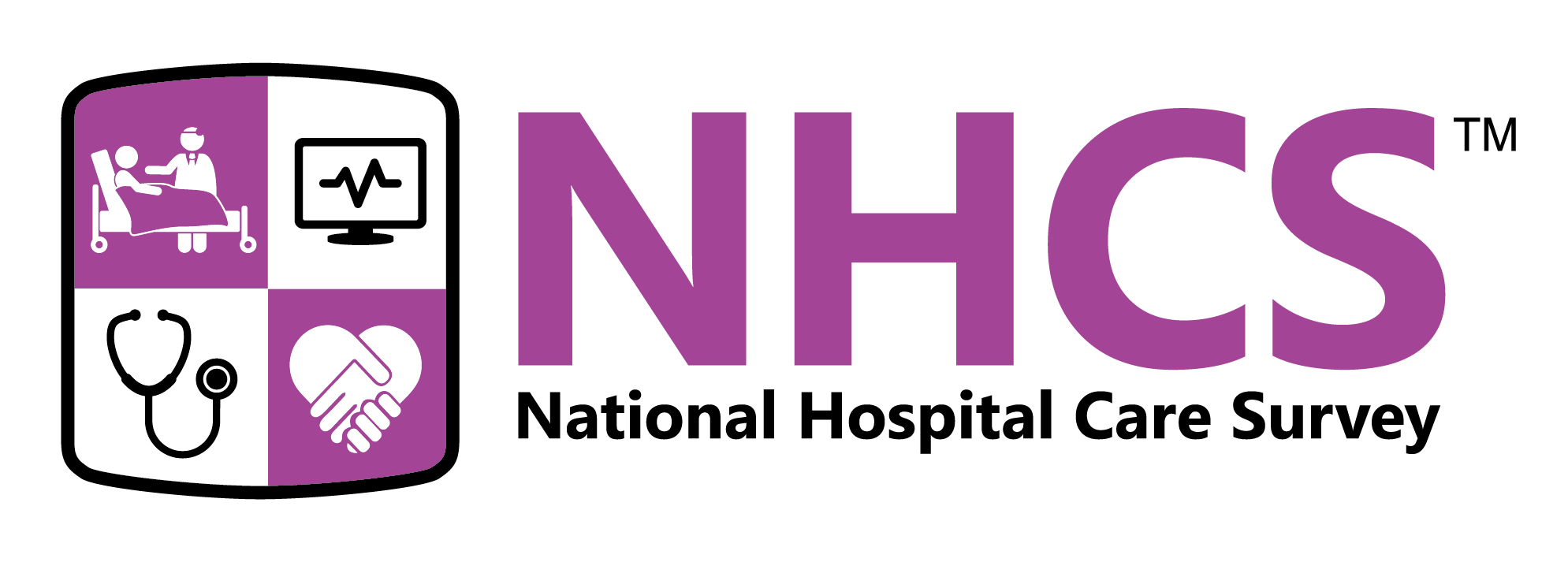Key points
- Explore this gateway to data from the National Hospital Care Survey (NHCS).
- Access important technical information to help you understand, analyze, and use NHCS data.
- Find information about datasets created by linking NHCS data to data from other sources.

About these resources
This page provides data documentation and other technical information for the National Hospital Care Survey (NHCS). Data users should review the NHCS Documentation and User's Guide before accessing other NHCS resources on this page. Together, these resources will help you understand, analyze, and use NHCS data.
Questionnaires
NHCS uses the Annual Hospital Interview (AHI) to collect hospital-level data, like total number of visits and total births. This sample AHI questionnaire shows the types of questions asked in the interview. AHI is a supplemental part of NHCS. The National Center for Health Statistics does not release AHI data.
Patient-level data is provided to NHCS via transfer of electronic health records, standardized medical claim forms (called UB-04 forms), or a copy of a similar file sent to the state health department. Therefore, NHCS does not use questionnaires to collect these data.
Datasets
Since the National Hospital Care Survey began in 2011, the National Center for Health Statistics has released datasets from the survey at irregular intervals.
In April 2024, National Center for Health Statistics released the first public-use data files from the National Hospital Care Survey. That dataset and its related documentation are linked below.
Access to all other National Hospital Care Survey datasets is restricted because of the sensitive information they contain. Restricted use datasets are available through the National Center for Health Statistics Research Data Center. Documentation for these datasets is provided below.
Linked data
Linking data is combining two or more datasets that have some related variables to create a new dataset. The new linked dataset maximizes the value of the original data. Researchers can analyze the new linked dataset to understand the relationships between different variables using data collected separately. For example, linking NHCS data with data from the National Death Index (NDI) produces a dataset that can be used to measure mortality after a patient left the hospital. These linked data also can provide information about the patient's cause of death.
NHCS data has been linked with data from several other sources, including NDI, the Centers for Medicare and Medicaid Services (CMS), and the Department of Housing and Urban Development (HUD). Access to these linked datasets is restricted and provided through the National Center for Health Statistics Research Data Center.
Preliminary data
Data files and documentation
Preliminary 2020 through 2024 National Hospital Care Survey data used in multiyear dashboards are available in the National Center for Health Statistics Research Data Center.
2021
Public-use data files and documentation
Inpatient department
Emergency department
Restricted data
The 2021 weighted and unweighted inpatient and ambulatory datasets are accessible through the National Center for Health Statistics Research Data Center.
Enhanced opioid-related data
The Patient-Centered Outcome Research Trust Fund funded a project to identify co-occurring disorders among opioid-involved hospital encounters in NHCS datasets. The project used an Enhanced Opioid Identification Algorithm to produce a restricted dataset of these encounters using 2021 data. That dataset is available in the National Center for Health Statistics Research Data Center.
2020
Public-use data files and documentation
Inpatient department
Emergency department
Restricted data
The 2020 weighted and unweighted inpatient and ambulatory datasets are accessible through the National Center for Health Statistics Research Data Center.
Enhanced opioid-related data
The Patient-Centered Outcome Research Trust Fund funded a project to identify co-occurring disorders among opioid-involved hospital encounters in NHCS datasets. The project used an Enhanced Opioid Identification Algorithm to produce a restricted dataset of these encounters using 2020 NHCS data. That dataset is available in the National Center for Health Statistics Research Data Center.
- 2019–2021 NHCS Data Enhanced Identification of Opioid-Involved Encounters data documentation
- 2019–2021 NHCS Co-occurring Disorders among Opioid-involved Hospital Encounters data documentation
Notice
Comparison of 2020 NHCS with other data sources
The following report compares estimates from the 2020 NHCS with estimates from other national sources of hospital data for selected outcomes.
2019
Restricted data
The 2019 unweighted inpatient and ambulatory datasets are accessible through the National Center for Health Statistics Research Data Center.
Enhanced opioid-related data
The Patient-Centered Outcome Research Trust Fund funded a project to identify co-occurring disorders among opioid-involved hospital encounters in NHCS datasets. The project used an Enhanced Opioid Identification Algorithm to produce a restricted dataset of these encounters using 2019 NHCS data. That dataset is available in the National Center for Health Statistics Research Data Center.
2016
Restricted data
The 2016 unweighted inpatient and ambulatory datasets are accessible through the National Center for Health Statistics Research Data Center.
Enhanced opioid-related data
The Patient-Centered Outcome Research Trust Fund funded a project to identify co-occurring disorders among opioid-involved hospital encounters in NHCS datasets. The project used an Enhanced Opioid Identification Algorithm to produce a restricted dataset of these encounters using 2016 NHCS data. That dataset is available in the National Center for Health Statistics Research Data Center.
Linked data documentation
- 2016 NHCS data linked to 2016–2017 NDI mortality data
- 2016 NHCS data with enhanced opioid-identification linked to the 2016–2017 NDI mortality data linked to 2016–2017 drug-involved mortality data
- 2016 NHCS data linked to 2016–2017 CMS Medicare enrollment, claims, encounters, and assessment data
- 2016 NHCS linked to 2015-2017 CMS Medicaid enrollment and claims data
- 2016 NHCS data linked to 2015–2017 HUD housing assistance data
- 2016 NHCS linked to Veterans Affairs administrative data files through fiscal year 2020
